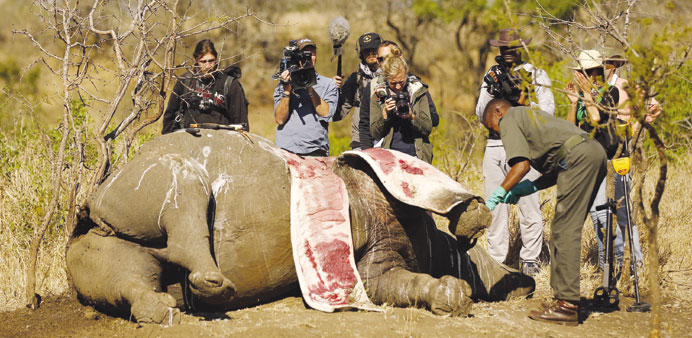Members of the media film as a ranger performs a post mortem on the carcass of a rhino after it was killed by poachers at the Kruger national park in Mpumalanga province in this picture taken on August 27. Poachers in South Africa now risk giving themselves away when they shoot, thanks to a high-tech, gunfire-detection system being tested in the country’s flagship Kruger National Park.
Reuters/Kruger National Park, South Africa
Rhino poachers in South Africa now risk giving themselves away when they shoot thanks to a high-tech, gunfire-detection system being piloted in the country’s flagship Kruger National Park.
The stakes are high, for rhinos are being slain in escalating numbers for their prized horns, alarming both conservationists and the government since wildlife in South Africa is an important tourist draw.
“ShotSpotter”, a product of privately-held California company SST Incorporated, has previously been used in crime-ridden urban US neighbourhoods to alert police to weapons fire.
In South Africa it has already yielded the arrests of an undisclosed number of poachers, earlier this year.
The matter is before the courts and park officials are reluctant to divulge details, saying that it could possibly expose the location of the ShotSpotter array to other poachers.
“This is my 14th war and the one I am determined to win,” said Otch Otto, a former soldier and UN peacekeeper who is now using his combat skills as Kruger’s joint operations manager in the poaching front lines.
As part of a pilot project, microphones have been planted in undisclosed areas of vast Kruger Park, the size of Israel.
When a shot is fired the origin of the sound is triangulated and sent to the service provider in the United States.
Co-ordinates are then relayed to a Kruger operations centre within 30 seconds, making it possible to deploy rangers and helicopters with precision.
ShotSpotter can detect gunshots up to 3km away, somewhat less if a weapon is equipped with a suppressor, or what Hollywood movies usually call a “silencer”.
On average, it can locate to within 10m the spot where a firearm has been discharged.
The company says it is the first time the technology has been employed outside of an urban environment.
Drones and other high-tech surveillance tools have also been used in the escalating battle with poachers. But the thick bush and high animal densities can thwart 21st century technologies.
“Our opponents are skilful, formidable people who know how to navigate in the thick of the night, taking cover under leaves and grass. You can’t win this war with helicopters and drones, the bush is too dense,” Otto said in his “war room”, plastered with aerial maps of the park sprawling across the country’s northeast.
More than 700 rhinos have been slain for their horns so far in this year South Africa, over 450 of them in Kruger.
More than 1,000 were poached last year, three times the tally in 2010, to meet soaring demand for rhino horn, coveted as an ingredient in traditional medicine and as a status symbol in fast-growing Asian economies such as China and Vietnam.
South Africa is the epicentre of the poaching surge because it is home to most of the world’s rhinos.
Elsewhere in Africa, elephants are being poached relentlessly for the ivory in their tusks.
The latest census from Kruger shows it has between 8,400 and 9,600 white rhinos and there are plans afoot to move 500 of them out of the park and hopefully out of harm’s way.
Most poachers slip into Kruger via the park’s 360km (220-mile) eastern border with Mozambique, one of the world’s poorest countries, where poaching and trade in rhino horn provide an income to impoverished villagers.
Kenya poaching crisis a ‘national disaster’
AFP/Nairobi
Kenya’s government has come under renewed pressure to declare a “national disaster” because of the rampant slaughter of elephant and rhino, with two major newspapers dismissing wildlife authority claims that the situation was under control.
Conservation groups have repeatedly said the state-run Kenya Wildlife Service (KWS) is losing the fight against poachers and the organised crime bosses that pay them, and that the country’s famed wildlife – key to the nation’s vital tourism economy – is on a fast track to destruction.
In a rare common call, top newspapers said more action had to be taken and they accused the KWS of sleeping on the job and trying to cover up the real extent of the poaching problem.
“Poaching is a national disaster,” the Standard newspaper said in its editorial. “KWS is being economical with the truth when it argues that poaching is not an immediate danger.”
“Those charged with preserving game must come out of their lethargy and realise that if it takes limiting access to our national parks to preserve endangered species for posterity, losing revenue from tourism for a while will be a small price to pay for a long-term gain.”
The Daily Nation newspaper said the ministry’s downplaying of the “brazen slaughter” was a “big surprise”.
“Officials cannot afford to pretend that the threat is not grave enough and let the poaching menace spiral out of control,” the Nation said.
A campaign group, Kenyans United Against Poaching (KUAPO), have gathered over 20,000 signatures in plea to Kenyan President Uhuru Kenyatta to “declare poaching a national disaster”.
But the environment ministry and KWS, in a report to lawmakers this week, insisted “Kenya is yet to reach such a critical stage”, and that calling the crisis a “disaster” would only scare off tourists.
“Drawing from the data on population growth and the incidence of poaching, it is reasonable to conclude that both elephant and rhino populations are not retarded by poaching,” top environment ministry officials Judy Wakhungu and Richard Lesiyampe told lawmakers, according to the Standard.
Officials also dismissed claims by conservation campaigners who say the figures of animals killed is far higher than government statistics.
“There are NGOs (non-governmental organisations) who go all over the world flashing these numbers as they raise money,” Lesiyampe said, according to reports.
Instead, the ministry has asked lawmakers to toughen existing anti-poaching laws.
Poachers slaughtered double the number of Kenyan rhinos in 2013 than the year before. Nearly a hundred elephants have been killed this year, according to official figures.



